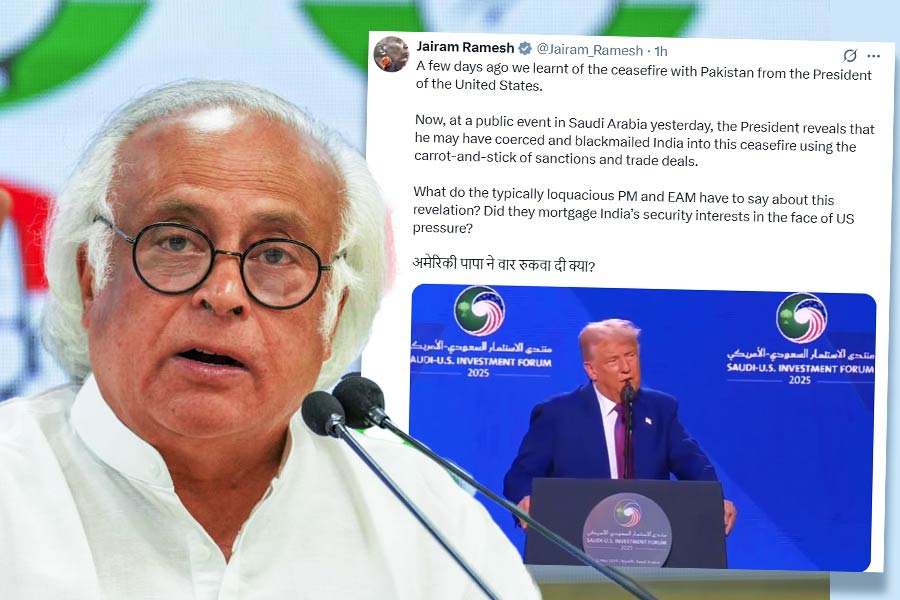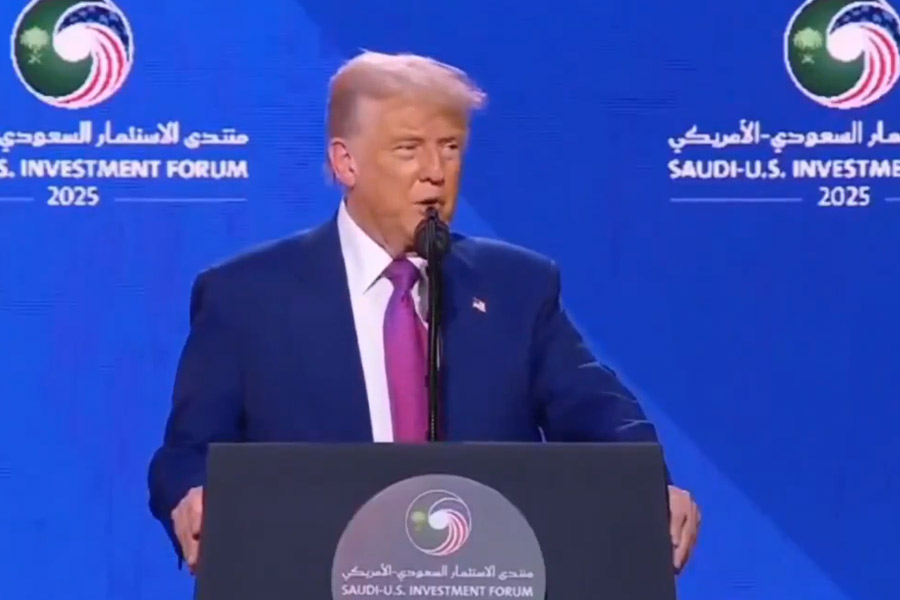|
|
| A stage of his own |
The fixation of Bengalis with the 19th century is not difficult to understand: it was during this century the empire the British built rained its favours on them. The Permanent Settlement spawned the bhadralok; surplus mercilessly squeezed from land helped this class of Bengalis to set up an urban culture. Elitist and under the overarching influence of European ideas, it spread its wings in different directions: education, social reforms, philosophical speculation, literary works, theatrical performances. A section of the bhadraloks ventured out on a bout of colonization of their own. They monopolized the professions of education, law and medicine over large chunks of northern and central India. Within the Bengal Presidency, some efforts also concentrated on modernizing the Bengali language and introducing one or two cautious changes in Hindu social norms. The concept of self-rule slowly seeped in here and there; its articulation, however, was by and large confined to obsequious petitions addressed to the Crown.
?Enlightened? Bengalis, immensely pleased with themselves, chose to describe this disorganized collage of activities as a renaissance. Love for clich?s apart, the hoity-toity Bengalis honestly believed they were going great guns. Succeeding generations of local scholars took their forebears at face value. A colonized people, after all, subsist on illusions. If there could be a Bengali Garrick or a Bengali Walter Scott, why not an aggregative Bengali renaissance as well? The so-called renaissance was overwhelmingly imitative. The outstanding creative genius emerging in the latter half of the century, Rabindra Nath Tagore, was not much thought of though in contemporary discourses.
The 20th century told a contrary story. The differential advantage the Bengalis had earlier enjoyed petered out. Conformism gradually gave way to dissent and revolt. The cult of terrorism came to displace the gentlemanly mode of giving vent to nationalist sentiments. A turbulent era ensued. The Non-cooperation and the Civil Disobedience movements were interspersed with violence against British civilian officials and policemen. The Quit India movement too was gory enough while it lasted; Subhas Chandra Bose?s exploits, some real, some imaginary, scaled to the top of Bengali legends. Famine and partition of the country finally marked the end of the long colonial affair for the Bengalis.
Conditions that followed were devastatingly traumatic. West Bengal was rapidly de-industrialized; problems the state faced were aggravated by the influx of millions of refugees. Discontent rent the air; it was a state of permanent rebellion through the decades. The left went from strength to strength, also from schism to schism. The Naxalite uprising tore further apart the social fabric. Repression let loose by New Delhi could make no dent on the left citadel. Once the interregnum of the Emergency was over, the Left Front took over in the state, seemingly on a permanent basis.
The middle decades of this century nonetheless witnessed an explosion of creativity in Bengal which had the hallmark of a genuine renaissance. Creative endeavours spurted, simultaneously, across several directions. Radical doings were matched by radical thought. Whether in scientific explorations, innovations in the educational system or literary efforts, the focus was on connecting with the rustic, humble people who made up the masses. While Tagore?s influence was pervasive, one has to keep counting names of illustrious Bengalis who contributed in different spheres: the list would include as much scientists like Satyendra Nath Bose and Meghnad Saha as the maestros Uday Shankar and Ustad Allauddin Khan along with their acolytes, thinkers and essayists such as D.P. Mukerji, Sushobhan Sarkar and Hiren Mukherji, poets of the stature of Sudhindranath Datta, Jibananada Das, Buddhadeb Bose, Bishnu De and Samar Sen. One could also hardly skip mentioning the three Bandyopadhyays ? Bibhuti, Manik and Tarashankar; the power and imagination of the fiction they wrote could compare with the best in world literature. Nor is it possible to forget Jamini Roy, whose native innovativeness and obsession with Nativity lent a new significance to Bengal?s painting. There were other ferments too. Exponents of sophisticated Tagore songs marched together with country balladeers. While it lasted, the enterprise of the New Theatres gave birth to a genre of Bengali films which were pace-setters for the rest of the country. A similar splurge of activities under the direction of the Indian People?s Theatre Association broke new grounds in theatrical themes and stagecraft. Great thespians like Sombhu Mitra and Utpal Dutt began to preside over the proceedings.
This is where Tapas Sen, who died last month, came in. In ordinary circumstances, Tapas Sen would have been a nobody, hovering in the rear of a ramshackle structure passing for an apology of a stage, the man in charge of lighting, working for an amateur troupe putting up a period piece of a play for the edification of a small-town populace. But he had imagination and pride ? and cheek. He had dreamt since childhood extravagant dreams about the magic of light and shade, about the nuances of light and the nuances of shade, about clashes between one layer of light and one layer of shade and between layers and layers of light and layers and layers of shade. These lights and shades filtered in his mind?s eye through the prism of audacious colours that cheered or saddened ? or just devastated the watchers.
The moment was right in the late Forties; Tapas Sen was caught up in the frenzy of the IPTA, and there was no looking back. He became, in due course, the miracle-maker with lights. He must be almost unique in the history of arts: a nondescript electrician thrust by popular accolade before the limelight. Reaching beyond participation in the production of plays, he went on to weave magic in the other performing arts, from there to other forms of visual arts and, further on, to illumination of statues, public mansions and even river bridges.
He became a celebrity. The danger though remains that the point Tapas Sen made via his creativity might be missed out in the melee. The analogy could appear as somewhat mawkish, but his views on lighting had a strong resemblance to Albert Hirschman?s theory of economic development. A poor country, the now-largely-forgotten Hirschman had insisted, should stop worrying over fancy infrastructure such as ten-or-twelve lane highways, ultra-modern ports or state-of-the-art telecommunications. That kind of indulgence would be a waste of an impoverished nation?s scarce resources, which should rather be concentrated on developing agriculture and industry. Once foodgrains, cash crops and industrial products are there in abundance, commerce would thrive in any case, goods would move even along rickety roads and be borne overseas in creaky boats.
The moral of Tapas Sen?s creations is closely similar. Consider the time some 60 years ago. The country was on the threshold of independence, but it was ? in fact, has remained ? poor and short of resources. Importing expensive equipment was beyond your reach. So what, you developed a rustic technology of lighting; you gathered apparently worthless, discarded things lying around, a torn half-length of a car tyre, a smashed headlamp from a bicycle, a faded piece of Manila rope, a semi-crushed plastic tumbler, a cracked hand-mirror thrown in the garbage, a worn out nightwear, a broken pelmet, cellophane wrappings from cigarette packets. Tapas Sen would stock up such junk and, wizardry at work, deploy them to meet the challenge of the situation. He would find a way to create the magical fa?ade of the King?s chamber in Raktakarabi, he would blast with waves of water the burning mine in Angar, he would blind each and all with the dazzle of the red flag fluttering over the ship in the thrall of an uprising in Kallol, he would create the fearsome splendour of a train speeding across the railway bridge over a rain-lashed surging river.
Such geniuses made the 20th- century Bengal renaissance, one yet to be acknowledged by the scholarly lot still glued in awe to the 19th century. Tapas Sen therefore departed only about one-quarter recognized. History, one hopes, will make amends for this outrage. If it does not, that would be its own loss.











